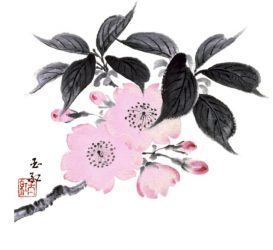Over the last six hundred years, Ikebana has become one of Japan’s traditional art forms. Originating with floral offerings to the dead, it became part of Buddhist rituals. Later, during the century-Long Civil War period of medieval Japan, it reached perfection as a popular art form. As time passed, Ikebana forms changed, and many schools of Ikebana arose. Yet, the varying Ikebana styles retain certain features in common, regardless of differences in age and school.
Unshin Ohara founded the Ohara School in the late 1800’s when Japan opened to the West. He originated the new concept called Moribana, recognized today throughout the world. Unshin was a well-known sculptor as well as an adept flower arranger. Replacing the previously used tall vase with a small opening, he originated and actually designed and fired the low, flat, wide-surfaced Moribana containers for the many colorful flowers from the West. This new container greatly enlarged the scope of expression available to Ikebana. It now became possible to recreate natural scenery in the container by a landscape arrangement, using multi-colored flowers from the western world, a color-scheme arrangement devised by Unshin. Since then, Moribana has become the main trend of Ikebana and has contributed enormously to its popularity.
After the death of Unshin in 1916, the second Headmaster, Koun Ohara, set up illustrations, to a lecture-demonstration system for large groups, with the new idea of using blackboards for explanations. Who had ever heard of flower arranging lessons on the radio? Well, Koun did it!
In 1939, Houn Ohara became the third headmaster. His exhibit took the limelight as a standard-bearer of a new period in the Ikebana world. After the Second World War, amid postwar confusion, he was the first to hold a flower exhibition as a symbol for peace. Going back to the art of the bold Momoyama Period, he captured the magnificence displayed by the Rimpa artists in their screens and paintings, and transported the feeling into the low containers with exciting combinations of materials. In contrast to the opulence of the Rimpa, his quiet, studied “literati” or Bunjin-cho arrangements encourage peace and reflection.
In 1966, after years of difficult negotiations, he succeeded in influencing thousands of flower arrangement schools to organize as the Japan Ikebana Association for more effective action to raise Ikebana standards. He was President of the Japan Ikebana Association and serves as one of the three Founding Sustaining Flower Master Advisors of Ikebana International.
In 1995, the Ohara School celebrated its 100th year anniversary. The school has its main offices in Tokyo and Kobe. There is an Ohara Center in New York, 56 chapters outside of Japan, and over 160 chapters within Japan.

